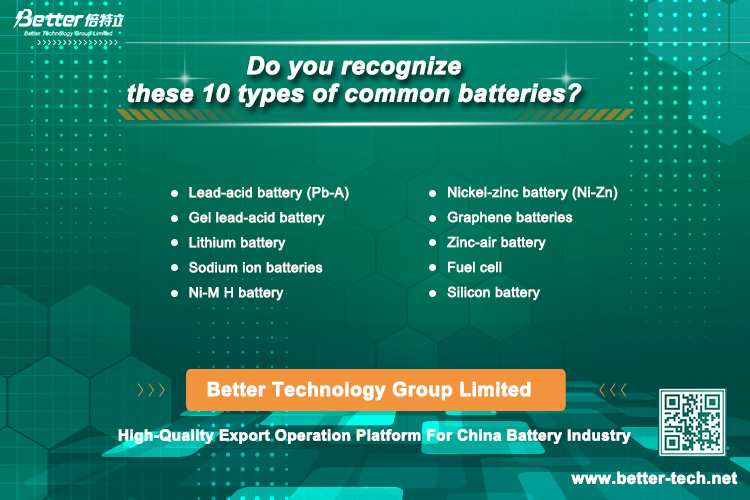
Do you recognize these 10 types of common batteries?
2022-03-23 17:201. What is lead-acid battery (Pb-A)?
Lead-acid battery, the electrode is mainly made of lead, and the electrolyte is sulfuric acid solution.
The representative symbols of lead-Acid batteries are Pb-A or L-A, in which Pb is the code name of lead in the periodic table of elements, L is the prefix of the English name Lead of lead and A is the prefix of the English name acid, both of which represent lead-acid batteries.
There are many kinds of L-A batteries, such as flat plates, spiral plate, etc.
Despite the rapid development of emerging battery industries such as lithium batteries in recent years, lead-acid batteries are still a power source with the most mature technology, the largest consumption in various fields, the largest market sales and the longest service time in the world due to their simple manufacturing process, abundant raw materials and high quality-price ratio. Lead-acid batteries used in electric bicycles belong to VRLA type, short VRLA type and square power lead-acid batteries.

2. What is lithium battery?
Lithium battery is a kind of battery which uses lithium metal or lithium alloy as positive/negative material and non-aqueous electrolyte solution. The material of lithium battery negative electrode is metal or lithium alloy material. It is dependent on the transfer of the positive electrode and the negative electrode at the beginning to complete the charge and discharge operation of the battery. Now the lithium battery mainly includes lithium iron phosphate battery, lithium iron manganate battery and ternary polymer lithium battery.
3. What is gel lead-acid battery?
Electrolyte is gel, so-called gel electrolyte, which is made of gel and sulfuric acid solution according to a certain proportion by a special process, is a milky white gel. Gel is scientific, it is not easy to cause plate sulfuration, and the battery container will not leak when it is broken. Low internal resistance, low self-discharge rate, self-discharge less than 3% per month, and good capacity recovery performance: after the discharge is close to OV, short-circuit the positive and negative electrodes for 24 hours, then recharge to the termination voltage, repeat the discharge and short-circuit discharge for 5 times, and the discharge termination voltage is 10.5V. After that, the battery capacity is still greater than 90% of the rated capacity. Under normal circumstances, the service life can reach 500 times. The voltage of gel battery is 0.5~1V lower than that of modern sealed battery, and the applicable temperature is 10℃~40℃, which is relatively resistant to low temperature.
4.What is Sodium ion batteries
Sodium-ion batteries, a type of rechargeable battery, rely on Sodium ions moving between the positive and negative electrodes to work in a similar way to lithium-ion batteries. That is, during the charging and discharging process, Na+ is inserted and released back and forth between the two electrodes: During charging, Na+ is removed from the positive electrode and embedded into the negative electrode through the electrolyte; it is opposite when discharging. The new 18650 sodium ion battery uses sodium ion transfer, rather than lithium ions, to store and release electricity.
5.What is Ni-M H battery?
At present, the commonly used (applicable) Ni-MH battery is a battery with metal hydride as hydrogen storage material. This kind of battery has a high energy-quality ratio, which is more than one time that of lead-acid battery. It has no excessive requirements for charging, and can be charged when the power is used up or not. If the battery is not charged in time after running out of power, it will not affect the battery life. Relatively light weight and small volume, large battery effective capacity, it can provide more electric energy, relatively high driving ability and long service life.
6.What is a nickel-zinc battery (Ni-Zn)?
The negative electrode material of nickel-zinc battery is zinc metal, which is easier to obtain and cheaper than the negative electrode material metal hydride in nickel-hydrogen battery. Its prospect is no less than that of nickel-hydrogen battery, and its service life should be longer than that of metal hydride. In terms of performance, it can completely discharge, and its rated capacity is the actual capacity of the battery, which can discharge all the electricity.
7.What is Graphene batteries?
Graphene technology is still in the development stage and is not yet ready for large-scale use. At present, graphene batteries used in China are essentially lead-acid batteries. Graphite powder is added on the basis of lead-acid batteries, which makes the batteries have excellent heat resistance, corrosion resistance and conductivity, so that the durability of the batteries has been greatly improved.
8.What is zinc-air battery?
It belongs to flooded, alkaline, open-type, plate-type electrode. The plate is consumable. Charging means changing a group of plates. It is not a secondary battery, but a chemical power generation device-fuel cell.
9.What is fuel cell?
In the field of electric vehicles, the 'proton exchange membrane fuel cells' in the fuel cell series are used successfully and at low cost, which belong to the laminated structure and are not charged, and the consumers are hydrogen or hydrogen compounds such as methanol, methane and hydrocarbons. The combustion-supporting agent is oxygen in the air.
10.What is a silicon battery?
High-energy, environment-friendly and maintenance-free fully sealed batteries, are made of non-liquid and non-gel electrolytes, special grid structure and material formula developed with invention patents and unique production technology.
